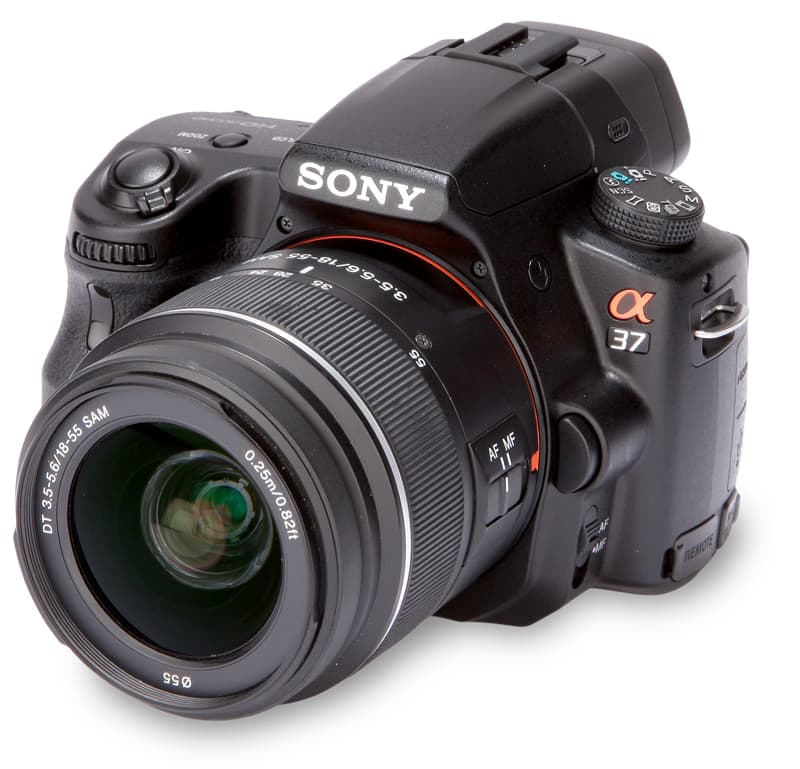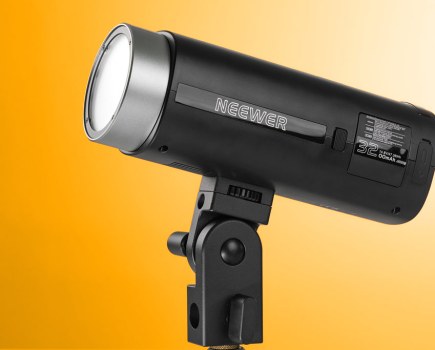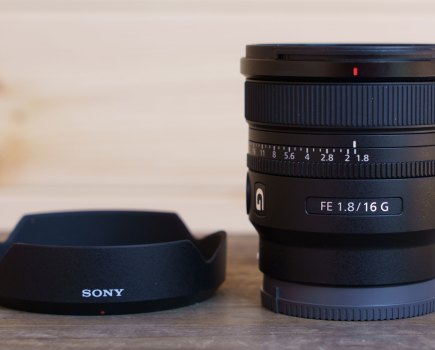Sony Alpha 37 at a glance:
- 16.1-million-pixel CMOS sensor
- Bionz III processor
- ISO 100-16,000
- 2.7in tilting LCD monitor
- 7fps continuous shooting mode
- Street price £399
Sony Alpha 37 review – Introduction:
Launched in tandem with the NEX-F3, the Sony Alpha 37 is designed to be the more ‘serious’ of the two cameras. The specifications of the two models may be similar, but Sony claims the type of photographer who will buy each product is notably different. While the NEX-F3 is aimed at the family user looking to document their children and holidays, the Alpha 37 user, according to Sony, has an ambition to be a photographer and to create photos rather than take snapshots.
To the unsuspecting eye, the Sony Alpha 37 looks indistinguishable from the rows of other entry-level DSLRs that line the shelves of camera stores. The principal difference, however, is that this is not a DSLR – not officially – as it lacks the crucial pentaprism optical viewfinder and moving mirror arrangement. Instead, this SLT (single-lens translucent) camera uses a fixed, semi-transparent mirror that directs 30% of the light to the AF sensor while allowing the remaining 70% to pass straight through to the sensor, which provides the electronic feed for the viewfinder display.
Sony now features SLT cameras in its beginner, intermediate and advanced ranges, with only two remaining DSLR-type cameras in the intermediate (Alpha 580) and professional categories (Alpha 900). SLTs, it seems, are the future for Sony’s A-mount cameras, but can they now compete with the best DSLRs?
Features
The Alpha 37 is an update of the Alpha 35, which was released in June last year. This is a short shelf life, even for a digital camera, but the update aligns the entry-level SLT and compact system camera models, so the only decision between the two comes down to how the buyer wants to use the camera.
Like the NEX-F3, the Alpha 37 features a new 16.1-million-pixel Exmor CMOS sensor, which has been paired with the Bionz III processor. This delivers a 3264×4912-pixel image, creating an almost A3-sized print at 300ppi. Files can be saved in a choice of JPEG or ARW, Sony’s own raw format. The camera comes with Sony’s Data Converter SR software, and the raw format is already supported by the latest updates to Adobe’s Camera Raw and Lightroom. The ISO sensitivity has been extended from the 12,800 on the Alpha 35 to ISO 16,000 on the Alpha 37, which, while only a 1⁄3EV increase, is impressive for such a camera.
This new sensor has also facilitated higher-quality HD video – an area that has seen a rapid advancement in digital cameras over the past couple of years. SteadyShot stabilisation features in the camera, allowing all lenses to benefit from the technology. This is one area where the Alpha 37 differs from the NEX compact system range, and is worth bearing in mind for anyone planning to use older lenses on the camera. As the Alpha 37 uses an electronic viewfinder, the sensor-based stabilisation will be a benefit to composition, steadying the monitor feed.
The metering options remain unchanged from the Alpha 35, offering a 1,200-zone metering system with a choice of multi, centreweighted and spot options. The exposure compensation – also unchanged – seems rather limited at ±3EV, compared to a now standard ±5EV in most models.
The usual PASM shooting modes are present, and are bolstered by an array of automatic and feature modes that allow simple operation and easy control of some of the camera’s more advanced features. The intelligent auto is accompanied by iAuto+ (Superior Auto), which includes automatic scene detection, continuous shooting and HDR options. So, when required, it will fire a burst of images and process them into a single file to deal with high-contrast or low-light situations. Also included is the Sweep Panorama mode, allowing real-time image stitching to create a panoramic shot as the camera pans. This can be saved in either 2D or 3D forms.
The Alpha 37’s impressive-sounding 7fps continuous shooting is only available in a limited scenario, and a more modest 5.5fps is the true maximum for use in most modes. There is a high-speed option on the mode dial for the 7fps shooting, and it provides a cropped, 8.4-million-pixel image and full auto exposure control. In reality, 5.5fps is more than enough for most users, and in the situations where a faster frame rate is actually needed the cropped view may well be an advantage, giving extended range from a particular lens. And an 8.4-million-pixel image is more than enough for most uses – plus, the smaller file size will stop the memory card filling up too quickly.
Using a high-speed Lexar Class 10 600x SDHC card, the Alpha 37 managed 21 frames in high-speed crop mode before slowing. In its standard 5.5fps operation, the number of frames was noticeably lower, however, with six JPEGs, five raw or four raw+JPEG frames taken before slowing. Writing an individual file took up to 2.5secs for a raw+JPEG, which shows fairly fast processing – it is just the size of the buffer that limits the number of shots.

Image: High ISO performance is impressive, and although signs of luminance noise are clearly visible at the top ISO 16,000 setting, theISO 1600 setting is still usable
Build and handling

The Alpha 37 is of a similar size and shape to the previous Alpha 33 and 35 models, but has a more pronounced indent on the grip, which surprisingly makes a notable difference to holding the camera. The body’s compact size means most users will only be able to fit two fingers around the grip, so this indent, combined with an indented rear grip for the thumb, is more appreciated.
The body is light but feels solid and well made. The numerous buttons are large and well spread. A dedicated exposure-compensation button allows the front dial to swap its control from aperture or, in manual shooting, changes from shutter control to aperture control. However, the angle of this button makes it difficult to operate without altering your grip.
An Fn button provides access to most controls, bypassing the main menu, and it is nice to see the ISO and white balance controls both accessed via quick buttons on the four-way control dial. The centre button also allows access to the AF control, from which the point can be adjusted in the local and zonal modes.
One clever feature present on many Sony models is Eye-Start, which activates the camera’s focusing when the viewfinder is put to the eye, reducing the time needed to take a shot. The only downside is that when the camera is held at waistlevel, Eye-Start can activate when the sensor is shaded, which causes the AF motors to whirr away as you walk along. This can be quite noisy with the kit lens mounted and the focus beep turned on, and it eats away at the battery.
Noise, resolution and sensitivity

These images show 72ppi (100% on a computer screen) sections of images of a resolution chart, captured using the Sigma 105mm f/2.8 macro lens.
We show the section of the resolution chart where the camera starts to fail to reproduce the lines separately. The higher the number visible in these images, the better the camera’s detail resolution at the specified sensitivity setting.
For a 16.1-million-pixel camera, the Alpha 37’s resolution performance is a little disappointing and lower than that for the NEX-F3 (perhaps due to the translucent mirror), although it more or less matches the scores of the Alpha 35 (AP 2 July 2011).
At its base ISO 100 it reaches 24 in JPEG and 26 in raw, which is maintained until ISO 1600 where the raw file decreases to 24. Noise levels start to increase above ISO 1600 and, as the noise reduction kicks in, on the JPEG at ISO 6400 the score drops to 22.
At the highest settings of ISO 12,800 and 16,000 performance is actually quite good, maintaining a score of 20 and 22 from the JPEG and raw files respectively.
Luminance noise is noticeable from ISO 6400 in the JPEG file, while raw images show luminance noise from ISO 800 and slight colour noise above ISO 6400, but this is easily removed.

Image: Overall detail is impressive from the Alpha 37 using the standard lens, with both raw and JPEG files delivering decent sharpness
Dynamic range

The image contains lots of detail in the shadow areas that can be easily revealed in post-processing. However, noise levels are increased
Sony Alpha cameras have all performed well in dynamic range tests, with the previous Alpha 35 offering 12.7EV from DxOMark.com. Although final measurements for the Alpha 37 are not yet available, from our test images it appears this sensor is equally impressive. Shadow areas contain huge amounts of unseen detail that can be rescued in editing software, and while slightly noisy, this means that by exposing for the highlights it is possible to capture a much wider range.
The addition of HDR controls, which combine multiple images, also works to extend the range further. The fast frame rate means that in reasonable light this can be performed handheld without the risk of blurring.
White balance and colour
The auto white balance performs well in a range of environments, providing neutral colours throughout. The option of four different fluorescent settings is handy for indoor work, while the custom set-up allows the use of spot focus to pick a neutral or white area in the scene for reference. These are extremely handy options when shooting JPEGs, though less of an issue for raw.
Colours straight from the camera look bright and punchy, but still natural. Most JPEGs could be considered ‘print ready’ without the need for any adjustment.
The creative styles in the Fn menu provide vivid, portrait, landscape and sunset presets, along with fine-tuning of contrast, saturation and sharpness for each.
Metering
The 1,200-zone metering system delivers accurate results and copes with difficult contrasting scenes. The priority is given to the scene as a whole, as opposed to the highlights as some users may prefer. However, a 0.3EV adjustment to the exposure compensation will ensure all highlights are maintained while shadows can be recovered using editing software.
Autofocus
The Alpha 37 features an extensive range of autofocus points for a camera of its class. It boasts 15 in all, spread fairly wide across the centre of the frame, and including three cross-type points. In comparison, Nikon’s D3200 has 11 points with one cross-type, and Canon’s EOS 1100D has nine-points with one cross-type. The object tracking works well in zonal, wide and local AF settings, following the subject around the frame with the closest AF point. Single focus is quick and accurate, only let down slightly by the noisy AF motors in the kit lens.
LCD, viewfinder and video
The LCD screen has gained the popular tilt control from other Alpha and NEX models, allowing a 135° up and 55° downwards rotation. This is useful for high-, waist- and, in particular, ground-level shooting. The downside, however, is that, in adding the tilt, the resolution of the 2.7in screen has dropped to a very basic 230,000-dot resolution. While this is usable, and it copes well with bright reflections, it is no match for the 3in, 921,000-dot screens we have come to expect from modern cameras.
The viewfinder, however, has been made larger than that on the Alpha 35, with 48% more pixels. This makes a difference when composing and certainly adds to the viability of an electronic viewfinder. In fact, with the added information available via this screen, it is hard to miss the optical view.
Video is captured in 1920×1080 pixels in a choice of 60/50i or 24/25p in AVCHD format, or 30p in MP4 format. Unusually for an entry-level model, the Alpha 37 features not only an in-built mono microphone, but also an external microphone input.
Our verdict
As entry-level cameras go, the Alpha 37 offers a lot of benefits. The array of clever features makes it easy to achieve some stunning results – so long as you have the composition to match. However, the new sensor doesn’t seem to have gone far enough to overcome the effect of the transparent mirror, leaving images lacking in detail and relatively high in noise.
An improvement in the resolution of the screen and a quieter kit lens would go some way to helping this model. Although I would miss the EVF at times, I would probably choose the more compact NEX-F3 over the Alpha 37.








